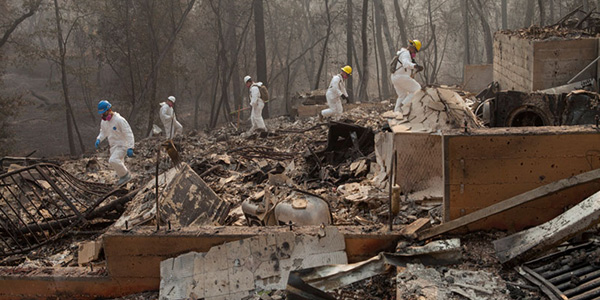By Hudson Sangree
Pacific Gas and Electric transmission and distribution lines caused the deadliest and most destructive fire in California history, state fire officials announced Wednesday.
The Camp Fire in rural Butte County flared the morning of Nov. 8 near the tiny community of Pulga. Within hours it killed at least 85 people, destroyed 18,804 structures and burned more than 153,000 acres. The fire destroyed the town of Paradise, population 27,000.
Investigators with the California Department of Forestry and Fire Protection (Cal Fire) said the fire’s main origin was beneath a PG&E transmission tower on the 100-year-old Caribou-Palermo line.
The department said in a statement that it made the determination “after a very meticulous and thorough investigation.”
A second ignition occurred nearby when vegetation contacted a PG&E distribution line, Cal Fire said. That second fire was consumed by the main blaze.
“The tinder dry vegetation and red flag conditions consisting of strong winds, low humidity and warm temperatures promoted this fire and caused extreme rates of spread, rapidly burning into Pulga to the east and west into Concow, Paradise, Magalia and the outskirts of east Chico.”
Cal Fire said it forwarded the results of the investigation to the Butte County district attorney for possible criminal investigation.
The announcement that PG&E started the fire was long awaited but not a surprise. The utility has already said its equipment most likely started the blaze.
“The act by Cal Fire of forwarding its report is strictly symbolic,” Butte County District Attorney Mike Ramsey’s office said in a statement Wednesday. “The fact the Camp Fire was started by a malfunction of equipment on a Pacific Gas & Electric Company transmission line has been known for months by investigators and had been, essentially, admitted by Pacific Gas & Electric in an early December 2018 report to the California Public Utility Commission.”
Ramsey said his office would provide no further comment on its investigation, “which is expected to last from weeks to months.”
The expected liability from the Camp Fire — currently estimated by PG&E to be about $14 billion — was a major reason the utility filed for bankruptcy in January. (See PG&E Wants to Undo Contracts, Revamp Biz in Bankruptcy.)
Cal Fire has also blamed PG&E for 18 of 21 major wildfires in 2017 that burned through Northern California wine country and the Sierra Nevada foothills.
All told, PG&E said it is facing more than $30 billion in liability for the 2017 and 2018 blazes.
‘Wrong Message’
California Gov. Gavin Newsom last month released a report criticizing PG&E for its lax safety standards and accusing the utility of “taking advantage of the bankruptcy process to promote the interests of investors over fire victims and other stakeholders.” (See Calif. Must Limit Wildfire Liability, Governor Says.)
The report said the state should monitor and intervene in the bankruptcy to protect California residents and keep open the option of breaking up the utility.
Acting in that vein, Newsom’s office on Wednesday asked the judge overseeing PG&E’s bankruptcy to deny the utility’s request for a six-month extension of its “exclusivity period” for producing a reorganization plan, urging the court to instead grant a 75-day extension at the most.
Under U.S. bankruptcy law, debtors normally have 120 days from the date of a bankruptcy filing in which to file a reorganization plan. Parties wanting to file a competing plan during that time must convince the judge to terminate the exclusivity period.
In a brief submitted to the U.S. Bankruptcy Court in San Francisco, Newsom said PG&E’s request “reflects no sense of urgency in addressing the serious problems and issues confronting” the company.
“The requested six-month extension is of particular concern because it encompasses the entirety of the 2019 wildfire season, thereby exposing PG&E to the risk of unquantifiable post-petition claims arising from 2019 wildfires,” Newsom wrote. “Such a prolonged extension of exclusivity to file a plan of reorganization would send PG&E and all of its stakeholders the wrong message. Allowing PG&E to continue a business-as-usual approach without any accountability would only encourage PG&E’s distressed-investors to leverage the Chapter 11 cases to their benefit and to the detriment of existing and future wildfire victims.”
Newsom reminded bankruptcy Judge Dennis Montali that PG&E entered bankruptcy as a convicted felon over its culpability for and obstruction of justice related to the 2010 San Bruno natural gas pipeline explosion.
“Nor should we ignore the reality that victims of the catastrophic fires in 2017 and 2018 suffered unimaginable losses and are still struggling to rebuild their lives,” Newsom said. “Allowing PG&E to remain in Chapter 11 without accountability will only unfairly cast doubt and uncertainty over the recovery on victims’ claims and prepetition settlement obligations.”
Robert Mullin contributed to this article.



